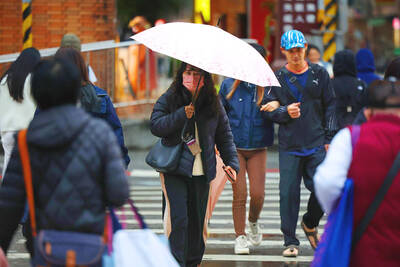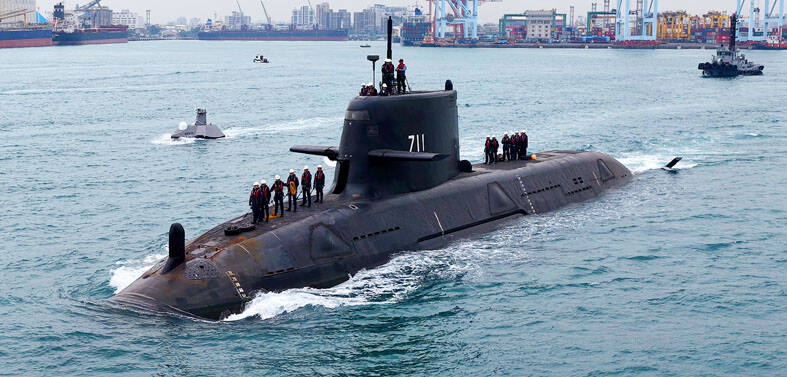The Matsu government unveiled a plan to attract military veterans and their families, the Matsu National Scenic Administration said yesterday.
Lee Chien-hsun (李建勳), a specialist at the administration, said the Lienchiang County Government estimated that approximately 3 million officers and soldiers had served their two-year mandatory military service on the county's islands. While some spent the entire two years in Matsu, others stayed there for a shorter period before transferring to other military bases around the nation.
Lee said that the county hosted a series of events to invite veterans to return for a visit to the military bases where they were once stationed.
“If these former servicemen bring their wives and children back to visit, the number of visitors could potentially top 12 million, or about half of the nation's total population,” he said.
Lee said the military infrastructure built before the central government lifted military control over the island in 1992 was one of Matsu's major tourist attractions.
Matsu, he said, is known for having the highest density of military tunnels in the world, adding that the Council of Cultural Affairs is planning to turn Matsu into a UNESCO World Heritage site along with several other sites around the nation.
Aside from its military legacy, Matsu has gained a reputation among bird watchers as a place to spot the endangered Chinese crested tern. Recently, Matsu's Daciou Island (大丘島) also drew attention after allowing tourists to watch the movement of Formosan Sika deer, Lee said.
The administration has remodeled an abandoned military camp at Da-aoshan (大澳山) on Matsu's Beigan Island (北竿島) and turned it into a War and Peace Memorial Park.
Yesterday, the exhibition center inside the park was opened to the public. Minister of Transportation and Communications Mao Chi-kuo (毛治國), Legislator Tsao Erh-chang (曹爾忠), Lienchiang County Commissioner Yang Sui-sheng (楊綏生) and about 20 veterans were invited to attend the plaque-unveiling ceremony.
Mao said he did his military service in Matsu.
While he was there, he said, he was in charge of drilling the Tangchi Tunnel (塘歧坑道) on Beigan Island, adding that the construction was completed in a year.
Recalling his time in Matsu, Mao said that he always trembled at the thought of bringing supplies to Liangdao (亮島), one of the smaller islands.
“It was such a rough boat ride,” he said. “You would start feeling nauseous before you reached the destination. The vomit and the horrible feeling you felt made you want to shoot yourself.”
Mao said he was also interested in Matsu's architectural style, which comes from the northern part of China's Fujian Province.
Mao said weather has restricted the development of tourism in Matsu because airports there are shut down whenever visibility is low. Many tourists have been afraid to come for fear their trips could be delayed by weather.
“If we emphasize Matsu as a mysterious and unique island and try to control the number of tourists in a sustainable manner, it will eventually help build up the island's reputation,” Mao said.

NUMBERS IMBALANCE: More than 4 million Taiwanese have visited China this year, while only about half a million Chinese have visited here Beijing has yet to respond to Taiwan’s requests for negotiation over matters related to the recovery of cross-strait tourism, the Tourism Administration said yesterday. Taiwan’s tourism authority issued the statement after Chinese-language daily the China Times reported yesterday that the government’s policy of banning group tours to China does not stop Taiwanese from visiting the country. As of October, more than 4.2 million had traveled to China this year, exceeding last year. Beijing estimated the number of Taiwanese tourists in China could reach 4.5 million this year. By contrast, only 500,000 Chinese tourists are expected in Taiwan, the report said. The report

Temperatures are forecast to drop steadily as a continental cold air mass moves across Taiwan, with some areas also likely to see heavy rainfall, the Central Weather Administration (CWA) said. From today through early tomorrow, a cold air mass would keep temperatures low across central and northern Taiwan, and the eastern half of Taiwan proper, with isolated brief showers forecast along Keelung’s north coast, Taipei and New Taipei City’s mountainous areas and eastern Taiwan, it said. Lows of 11°C to 15°C are forecast in central and northern Taiwan, Yilan County, and the outlying Kinmen and Lienchiang (Matsu) counties, and 14°C to 17°C

SHIPS, TRAINS AND AUTOMOBILES: The ministry has announced changes to varied transportation industries taking effect soon, with a number of effects for passengers Beginning next month, the post office is canceling signature upon delivery and written inquiry services for international registered small packets in accordance with the new policy of the Universal Postal Union, the Ministry of Transportation and Communications said yesterday. The new policy does not apply to packets that are to be delivered to China, the ministry said. Senders of international registered small packets would receive a NT$10 rebate on postage if the packets are sent from Jan. 1 to March 31, it added. The ministry said that three other policies are also scheduled to take effect next month. International cruise ship operators

STEERING FAILURE: The first boat of its class is experiencing teething issues as it readies for acceptance by the navy, according to a recent story about rudder failure The Hai Kun (海鯤), the nation’s first locally built submarine, allegedly suffered a total failure of stern hydraulic systems during the second round of sea acceptance trials on June 26, and sailors were forced to manually operate the X-rudder to turn the submarine and return to port, news Web site Mirror Daily reported yesterday. The report said that tugboats following the Hai Kun assisted the submarine in avoiding collisions with other ships due to the X-rudder malfunctioning. At the time of the report, the submarine had completed its trials and was scheduled to begin diving and surfacing tests in shallow areas. The X-rudder,